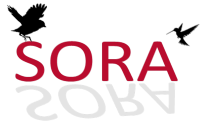Editorial
TRISTAN DA CUNHA
Nothing seems to be known about the reactions of Admiral Tristao da Cunha to the sights and sounds of the islands that now bear his name. Did he, for instance, remark on the myriads of clamouring seabirds that must have circled his ship? It was in 1506 A.D., long before human foot, cat's paw, hooves of livestock and rodents' toenails had left their imprints. In the circumstances, the remarkable thing is that Dr M.E. ('Mike') Richardson, the record of whose two years of observations on the birdlife of the Tristan da Cunha and Gough Islands occupies the whole of this issue of Cormorant, is able to confirm that the populations of several seabird species still run into the estimated millions.
In case some Cormorant readers are inclined to cavil at the amount of space also devoted in Mike Richardson's paper to the six species of landbirds that have established themselves on the islands, not to mention the ever-growing list of stray herons, gallinules, swallows and, especially, waders, it should be remembered that even if none of the latter survive and the numbers of the former are few, they or their ancestors have all performed the feat of crossing, at the very least, some 1900 km of ocean and living, however briefly, to tell the tale. So perhaps they deserve to be treated as honorary seabirds!
These introductory remarks can be suitably closed by taking a look at the milestones in the ornithological history of the islands. In 1816 and 1817 much time and effort were expended on installing a garrison on the main island of Tristan da Cunha and removing it again except for Corporal Glass, his wife and one or two others who elected to stay behind. Much involved in this operation was Captain Dugald Carmichael who not only was the first to climb to the 2060 m summit of Tristan but also published its first bird list in the Transactions of the Linnaean Society of 1818. After a longish pause the steady expansion of the list and knowledge of the birds began to take effect in the 1870's. They were brought to a head by Yngvar Hagen's report on the Norwegian expedition to the islands of 1937-38, which due to world War II could not be published until 1952. Again there was a period of amendments and additions to Hagen's account, and the next major step forward, in the years following the volcanic eruption on Tristan in 1962, was N.M. Wace and M.W. Holdgate's Man and Nature in the Tristan da Cunha Islands (published by IUCN in 1976 and deserving of constant reference). An indication of the rapidly increasing interest in the islands is the fact that Hagen quoted only some 50 references, whereas Wace and Holdgate had no less than 245!
Finally, although publications arising from the Denstone College expedition to Inaccessible Island of 1982-83 have already begun to appear with ornithological papers by M.W. Fraser in Ostrich and the Bulletin of the British Ornithologists' Club, the major step forward to date is undoubedly Mike Richardson's paper. It gives a detailed account of Tristan and Gough birdlife backed by much fascinating detail and should be the starting point of further studies for many years to come. The African Seabird Group and the Editor of its journal are to be congratulated on making its publication possible despite the many difficulties of time and distance.

